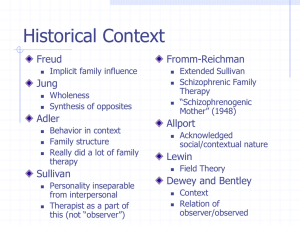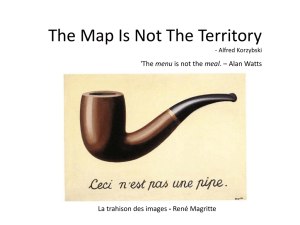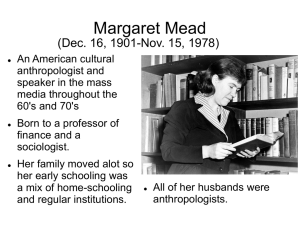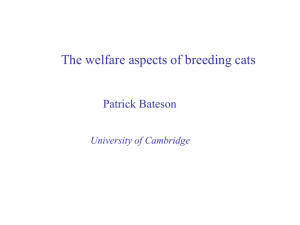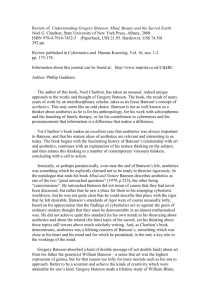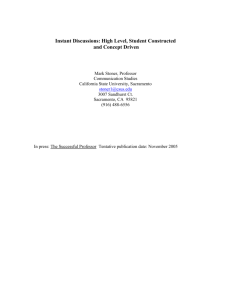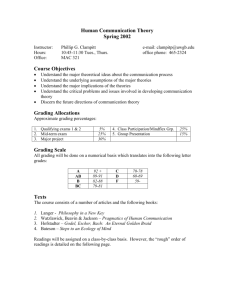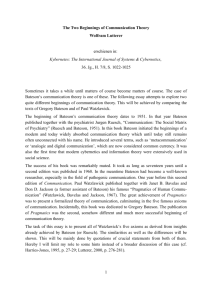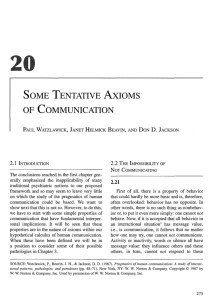Review of Understanding Gregory Bateson: Mind
advertisement
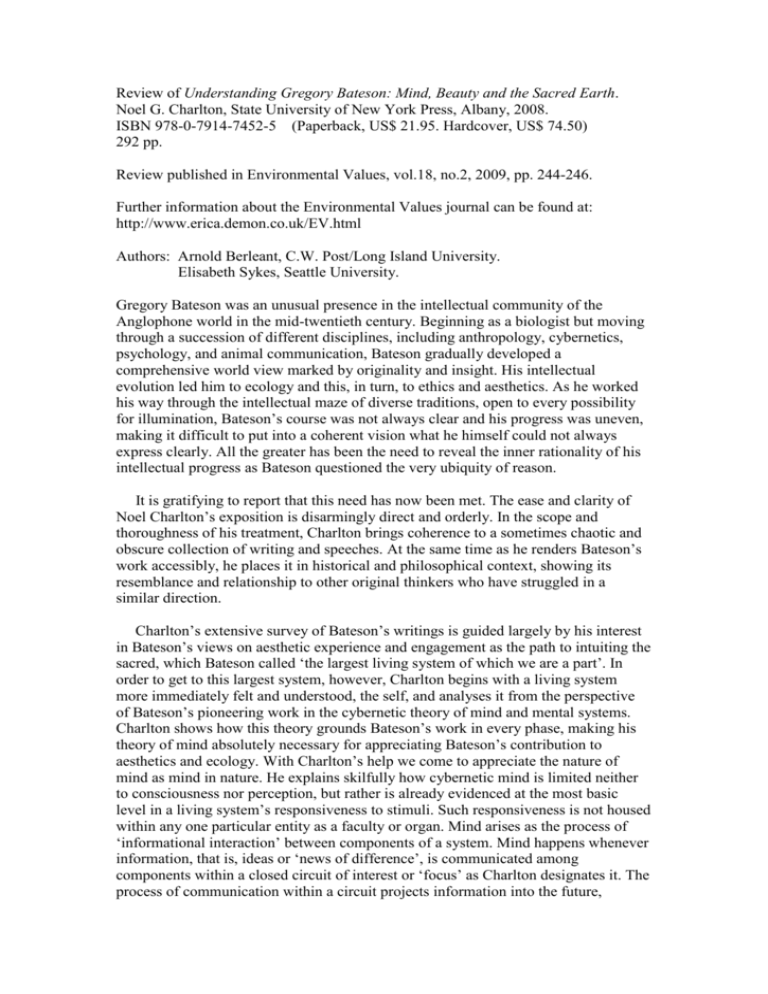
Review of Understanding Gregory Bateson: Mind, Beauty and the Sacred Earth. Noel G. Charlton, State University of New York Press, Albany, 2008. ISBN 978-0-7914-7452-5 (Paperback, US$ 21.95. Hardcover, US$ 74.50) 292 pp. Review published in Environmental Values, vol.18, no.2, 2009, pp. 244-246. Further information about the Environmental Values journal can be found at: http://www.erica.demon.co.uk/EV.html Authors: Arnold Berleant, C.W. Post/Long Island University. Elisabeth Sykes, Seattle University. Gregory Bateson was an unusual presence in the intellectual community of the Anglophone world in the mid-twentieth century. Beginning as a biologist but moving through a succession of different disciplines, including anthropology, cybernetics, psychology, and animal communication, Bateson gradually developed a comprehensive world view marked by originality and insight. His intellectual evolution led him to ecology and this, in turn, to ethics and aesthetics. As he worked his way through the intellectual maze of diverse traditions, open to every possibility for illumination, Bateson’s course was not always clear and his progress was uneven, making it difficult to put into a coherent vision what he himself could not always express clearly. All the greater has been the need to reveal the inner rationality of his intellectual progress as Bateson questioned the very ubiquity of reason. It is gratifying to report that this need has now been met. The ease and clarity of Noel Charlton’s exposition is disarmingly direct and orderly. In the scope and thoroughness of his treatment, Charlton brings coherence to a sometimes chaotic and obscure collection of writing and speeches. At the same time as he renders Bateson’s work accessibly, he places it in historical and philosophical context, showing its resemblance and relationship to other original thinkers who have struggled in a similar direction. Charlton’s extensive survey of Bateson’s writings is guided largely by his interest in Bateson’s views on aesthetic experience and engagement as the path to intuiting the sacred, which Bateson called ‘the largest living system of which we are a part’. In order to get to this largest system, however, Charlton begins with a living system more immediately felt and understood, the self, and analyses it from the perspective of Bateson’s pioneering work in the cybernetic theory of mind and mental systems. Charlton shows how this theory grounds Bateson’s work in every phase, making his theory of mind absolutely necessary for appreciating Bateson’s contribution to aesthetics and ecology. With Charlton’s help we come to appreciate the nature of mind as mind in nature. He explains skilfully how cybernetic mind is limited neither to consciousness nor perception, but rather is already evidenced at the most basic level in a living system’s responsiveness to stimuli. Such responsiveness is not housed within any one particular entity as a faculty or organ. Mind arises as the process of ‘informational interaction’ between components of a system. Mind happens whenever information, that is, ideas or ‘news of difference’, is communicated among components within a closed circuit of interest or ‘focus’ as Charlton designates it. The process of communication within a circuit projects information into the future, generating positive or negative feedback within the circuit. How the components within the system then respond to feedback will determine the future health, survival, and evolution of that system. Charlton asks, ‘Are we really a single entity, controlled and managed by a conscious internal mind? Are there not entities within our bodies that have their own independence? Are our ‘selves’ not significantly shaped and altered by larger physical and social processes that can also be seen as minds? (p. 33). Using concrete examples to explain Bateson’s concept of mind and its implications for a theory of self, Charlton shows that conscious awareness is only one very small part of the process that makes up the living system of the self. The body is composed of organs, each engaged in complex interactions within itself and with other components of the body. We find comparable mental processes in social systems and communities, each enfolded in the other: the family, friendships, institutions, even the political ‘mind’ of a nation. In the continuous dialogue between components at various levels of complexity we see not a unified self but the functioning of nested, hierarchical mental systems or minds. Thus the self is effectively a non-being, determined not by egoconsciousness, a brain, a membrane, or the skin. The cybernetic self, like all living systems, is fundamentally unbound. The ‘self’ is the name for a process that communicates differences in relationships along a circuit of interest in a particular respect and at a particular time. Such an idea challenges many of the fundamental habits of thought entrenched in Western culture. Most of these habits – bad delusional habits, in Bateson’s view – stem from a Cartesian dualism that posits the mind or ego-consciousness as a reified substance and turns material bodies in the world into objects dependent on and manipulable by this eco-consciousness. Separation of mind and body, self and world, has fostered a vicious cycle of escalating war between the human ego and the very world or system on which it depends for life: the planetary ecosystem as a whole. Charlton then charts the development of Bateson’s ideas in aesthetics and ecology through the sequence of his publications, showing how their course was cumulative. Central to this process was Bateson’s growing understanding of consciousness as extending beyond language and purposive rationality to include art, dreams, poetry, and other aesthetic practices. These reflect aesthetic engagement because, in saying that something is beautiful, we have perceived a set of relationships in it ‘and in ourselves’. It might at first seem surprising that Bateson placed the aesthetic in so central a position in his ordered view of things. There is a sense in which he finds the aesthetic almost merging with the sacred and infusing every system. For art and the aesthetic are, like science, participatory processes of mind. One might think it unusual for a scientist like Bateson to find his way leading to aesthetics and the sacred. These, however, clearly followed from his systemic view of things. The key to human recovery and successful adaptation is to recognise the link between the beautiful and the ecologically healthy. The activity of art, Bateson thinks, is more than conscious, and it is aesthetic engagement that provides the grace to enable us to reintegrate ourselves within the ecology of the world. Recognising this integration can promote and enhance our aesthetic engagement. It also promotes our sense of reverence, love, respect, and awe as part of the informational process of the material world. Charlton calls this ‘reverential monism’ and offers an extended and illuminating explanation of what this involves, ending his account with a call to action in realising the Batesonian ecological world view. Bateson’s work crossed may fields and has had a wide influence. His pioneering work in cybernetic theory of mind allowed him to venture into disparate areas of research and return with insight into the patterns of connection that comprise the whole. Groping as he did for ways of identifying and articulating explanations, his writing was often difficult or obscure. Noel Charlton has made a signal contribution, not only to rendering the work of Bateson as a coherent whole but, in doing so, making clear and convincing Bateson’s valuable contribution to environmental values.
